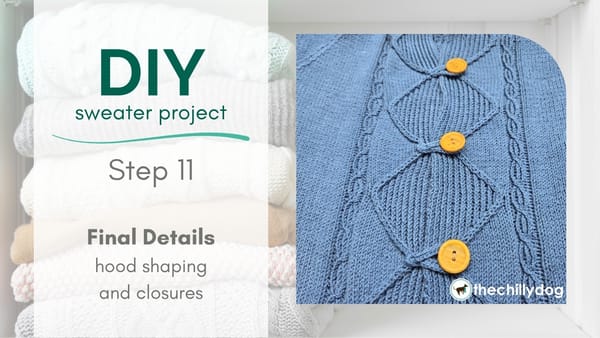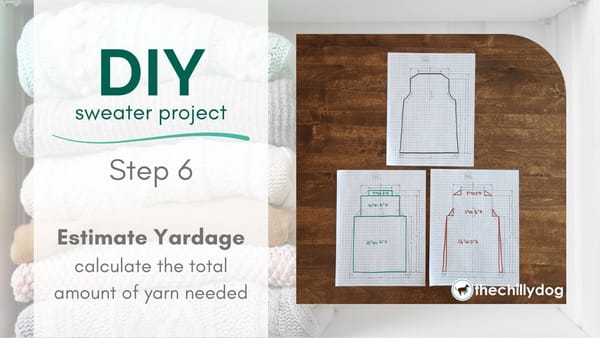
Estimating the total amount of yarn required
I've sketched my sweater pattern to scale and swatched to choose my yarn, stitch pattern and gauge. Now I have almost enough information to make a good estimation of how much yarn I'll need to knit my sweater. This step requires a little math, but again it's nothing more complicated than what you learned in middle school. I will also use one slightly unusual piece of equipment to estimate my yarn usage, a food scale.
Calculate the total area of the sweater
Before I can estimate my yarn usage, I need to figure out the total area of my sweater. To do that I'll calculate the area of each sweater piece (back, fronts, sleeves, etc.), then add them together.
Since I have each piece sketched to scale, I could count the total number of squares to find the area, but that would require a lot of counting. It will be quicker to calculate the area. I'll demonstrate the process with my sweater back.
Divide the sweater back into rectangles
It's easy to calculate the area of a rectangle. Area = width x height. Unfortunately, my sweater back is an irregular shape.
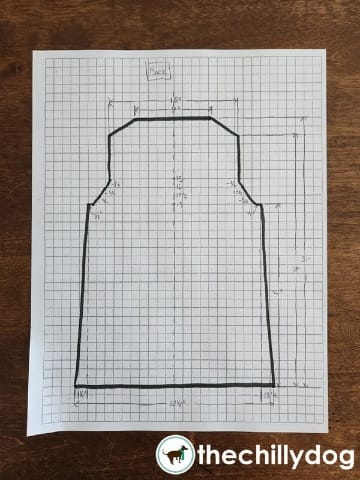
I'll break it down into simpler parts. First I draw 3 large rectangles inside my sweater back and note their width and height.
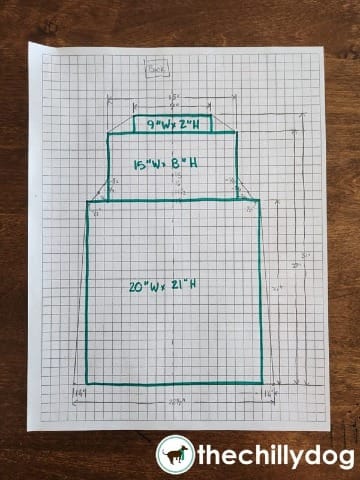
I calculate the area of each rectangle.
- 21" x 20" = 420 in²
- 15" x 8" = 120 in²
- 9" x 2 " = 18 in²
I add those up and so far the area of my sweater back is 558 in². But that doesn't account for all the small, triangular sections.
Geometry refresher
Before I find the area of the triangular bits, here's a quick geometry refresher. If I have two equal-sized right triangles, I can put them together like two puzzle pieces to create a rectangle.
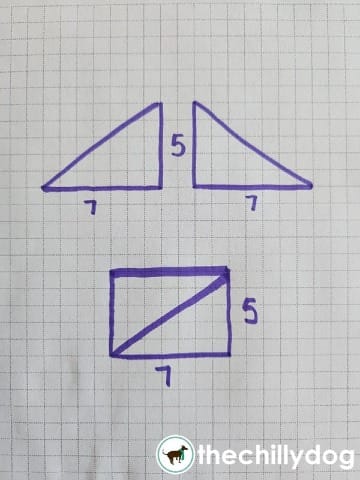
Find the area of the remaining triangles
Now I'll find the area of the remaining triangles.
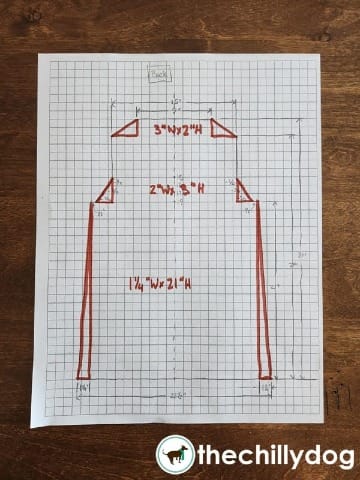
I calculate the area of each pair of triangles.
- 1.25" x 21" = 26.25 in²
- 2" x 3" = 6 in²
- 3" x 2 " = 6 in²
The area of the triangular parts add up to 38.25 in².
Total area of the sweater back
The total area of the sweater back is the area of the rectangles plus the area of the triangles.
558 in² + 38.25 in² = 596.25 in²
To keep my math simple I'm going to round that up to 600 in².
Find the total area of the sweater
I use the same process, dividing each sweater piece into simple rectangles and triangles, to calculate the area of the sweater fronts, sleeves and hood of my sweater.
- Sweater Back = 600 in²
- 2 Sweater Fronts = 600 in²
- 2 Sleeves = 460 in²
- 2 Hood Halves = 290 in²
Then I add up the area of each piece to determine the total area of the sweater.
Total area = 600 in² + 600 in² + 460 in² + 290 in² = 1950 in²
Estimate yarn usage of gauge swatch
Measure the mass of the swatch
Now I need to figure out how much yarn I used for my swatch. The easiest way to do this is by weighing the swatch with a food scale. My swatch is 9 g.
Calculate the area of the swatch
After blocking, my swatch is 5.25 inches wide x 4.5 inches high, or 23.625 in²
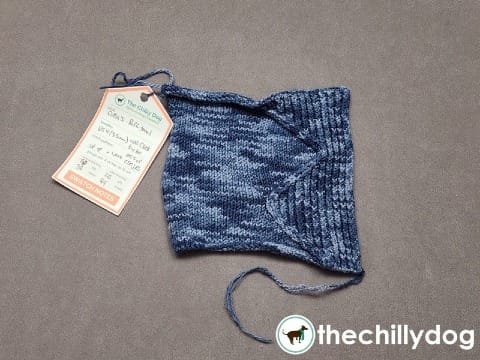
Calculate total yarn usage
I can use ratios to solve the problem:
mass of swatch ÷ area of swatch = mass of sweater ÷ area of sweater
I multiply both sides by the area of the sweater and get:
area of sweater x (mass of swatch ÷ area of swatch) = mass of sweater
Plug in the numbers:
1950 in² x (9 g of yarn ÷ 23.625 in²) = 743 g = mass of sweater
Also, I generally err on the side of caution and get an extra skein, just in case.
Final considerations
Way back at the beginning of this post I said that I would be figuring out my yarn usage estimate. This is not the exact amount of yarn I'll use, but it's reasonably close. There a few things that could impact my calculations and/or my actual yarn usage.
- Simplifying the area of the sweater pieces makes the math easier, but... Over-simplifying the area can induce a bit of error.
- The bigger the swatch, the more accurate the usage calculation. It's hard to get accurate dimensions and mass measurements on a small swatch which could lead to a significant difference between the estimate and actual usage.
- The swatch gauge may differ from the actual sweater gauge. I'm not a machine, so there will be moments that I knit looser or tighter as I make my sweater.
- As I knit, I may choose to make modifications to the shape of my sweater which haven't been factored into the calculations.
Finally, if at some point I decide to knit this sweater with a different yarn/needle combo than what I used for my initial swatch, I will need to knit a new swatch. The area of my sweater will stay the same, but I'll re-estimate the yarn usage of the new swatch to re-calculate the total yarn usage.
Keep that gauge swatch handy! In the next step we'll be using our gauge to convert the dimensions of our design into the number of rows and stitches so we can start knitting.
Yarn and needle support provided by

Join the conversation

Color Interaction
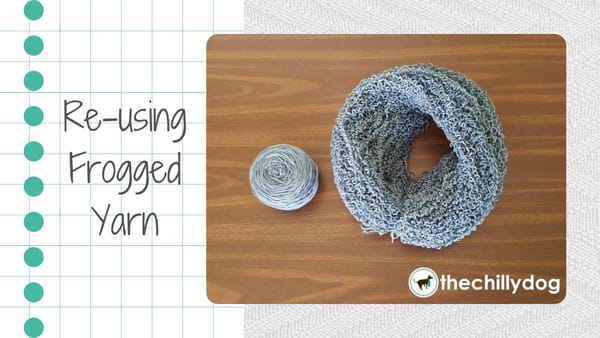
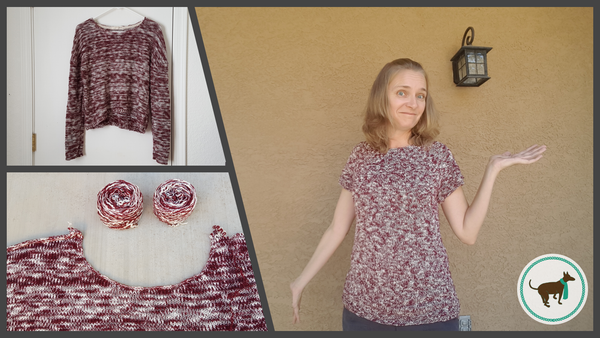
Frogging Doesn't Mean Failure
